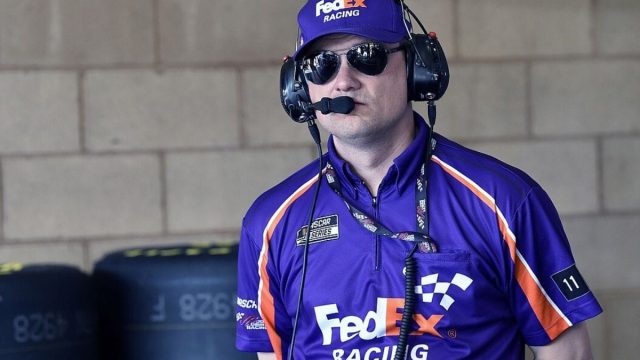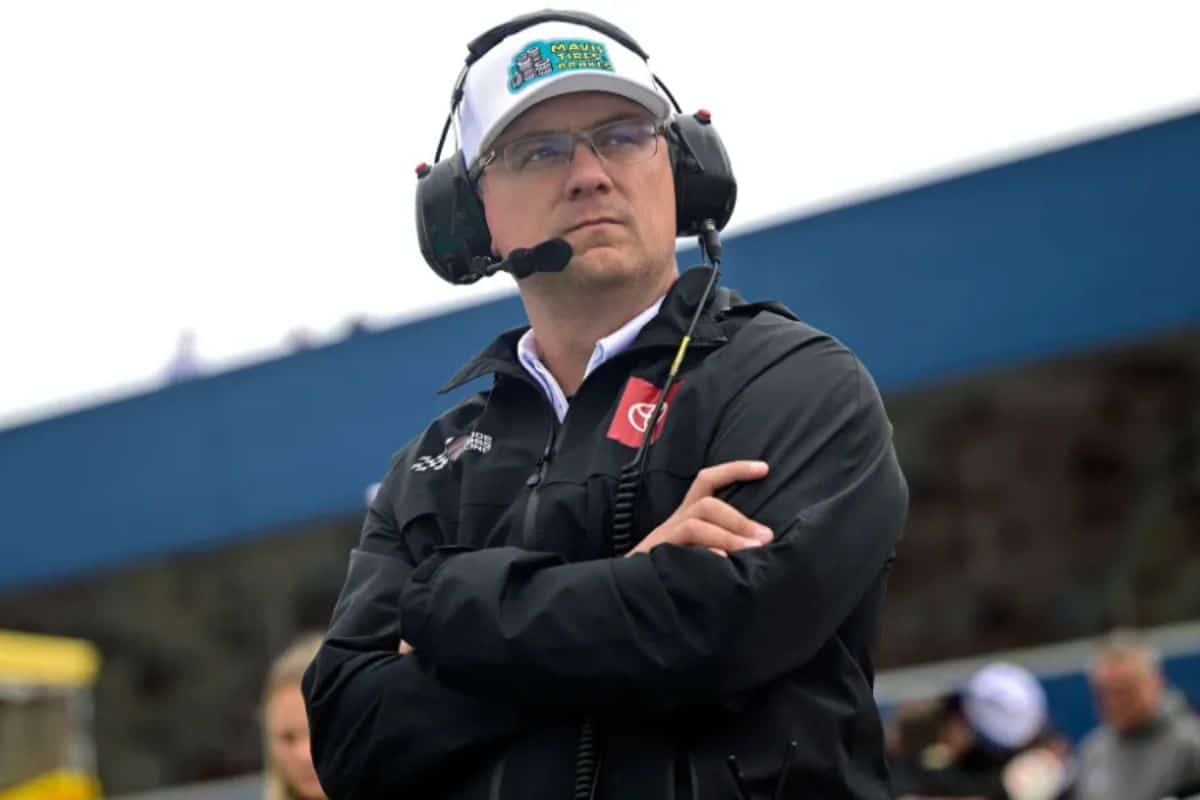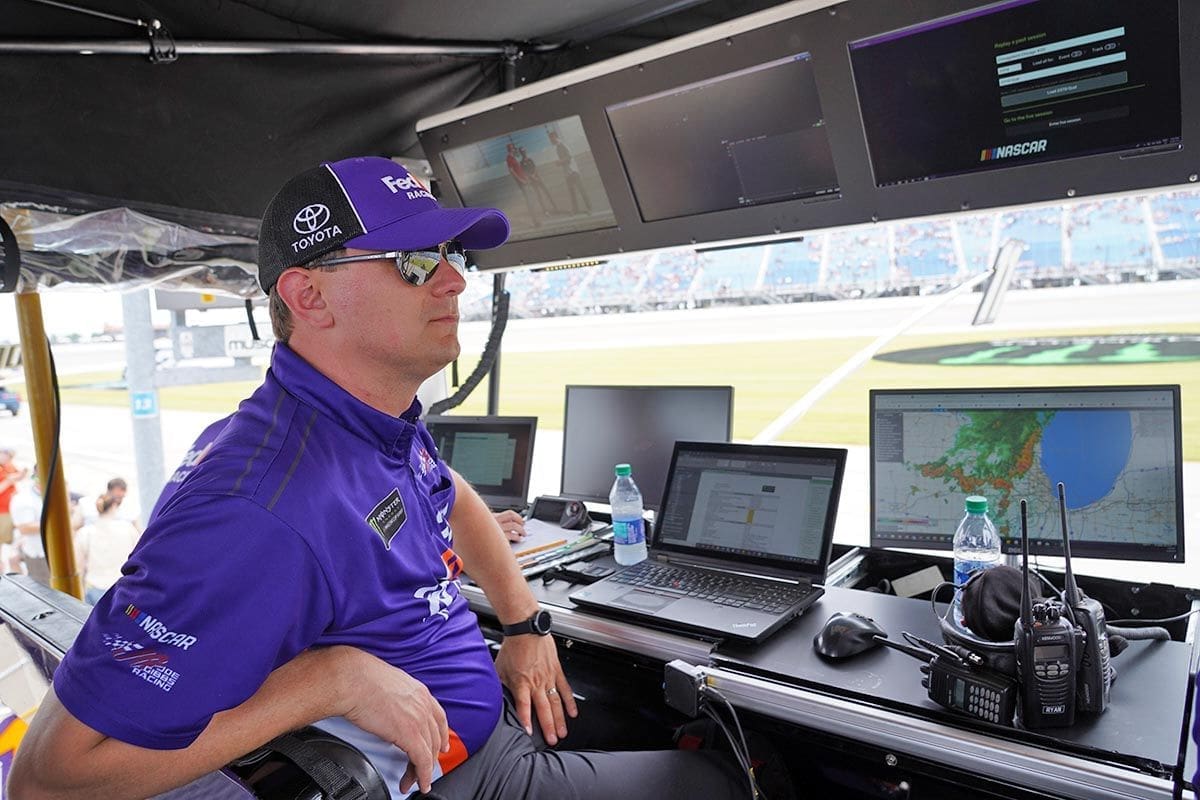Chris Gabehart Urges NASCAR: In a compelling call to action, Chris Gabehart, crew chief for Denny Hamlin, has highlighted the pressing need for NASCAR to recalibrate its approach to competition. By addressing the critical imbalance between horsepower and grip, Gabehart advocates for a more balanced playing field that truly tests the skill and strategy of drivers and teams. His suggestions, such as increasing horsepower or reducing tire footprint, aim to improve race dynamics and foster genuine competitiveness. As NASCAR contemplates these potential adjustments, the implications for future races and the sport’s overarching integrity remain a focal point of discussion.
Key Highlights
- Chris Gabehart highlights the need to recalibrate the horsepower-to-grip ratio for fairer competition.
- Gabehart suggests narrowing tires to increase the challenge and showcase driver skill.
- He calls for more transparent and consistent decision-making in race procedures.
- Gabehart emphasizes the importance of balancing safety with competitive integrity.
- He critiques the Next Gen car’s design for inadvertently creating performance imbalances.
Chris Gabehart on Parity Challenges in NASCAR
Chris Gabehart, Denny Hamlin’s veteran crew chief, has openly addressed the multifaceted challenges of achieving true parity in NASCAR. Gabehart’s insights explore the inherent complexities that physics imposes on the sport, which often hinder efforts to level the competitive playing field. While acknowledging NASCAR’s noble aim to create parity among teams, he emphasizes that certain factors, particularly relating to the dynamics of the Next Gen cars, introduce quantifiable disadvantages.
Gabehart points to an imbalance between horsepower and grip as a central issue. The Next Gen cars have been designed with the intention of equalizing performance, yet this has inadvertently created new hurdles. The physics of aerodynamics and mechanical grip are not easily reconcilable with the power output of the engines, resulting in disparities that are difficult to mitigate. These discrepancies manifest in track performance, where even minuscule variations can lead to significant competitive advantages or disadvantages.
Furthermore, Gabehart’s viewpoint is informed by his extensive experience and the current standing of his driver, Denny Hamlin, who is in his 20th Cup season and holds three wins this year, positioning him in the top tier of the driver standings. This perspective provides Gabehart with a unique understanding of how these technical imbalances play out over a season.
Impact of Recent Race Decisions
The recent race decisions, particularly during the USA Today 301 at New Hampshire, have sparked considerable debate within the NASCAR community regarding their impact on competitive fairness and race outcomes.
Denny Hamlin, a front-running driver, was notably impacted by a lengthy rain delay and subsequent decisions made by NASCAR. The race was restarted with a non-competitive pit stop that advantaged teams low on fuel, resulting in Hamlin’s drop from a potential top-three finish to P24.
This decision, although made with safety in mind, has raised questions about the balance between ensuring driver safety and preserving competitive integrity. The predicament faced by Hamlin underscores a broader issue within NASCAR: the challenge of making real-time decisions that do not inadvertently skew the competition.
Chris Gabehart tells @KevinHarvick that parity is a great goal but the "problem is physics gets in the way." He has some suggestions for the Next Gen car. #NASCAR pic.twitter.com/5OROsRlir5
— HarvickHappyHour (@HarvickHappyPod) June 27, 2024
Analysts argue that NASCAR’s decision-making process needs to be more transparent and consistent to maintain trust among competitors and fans alike. The situation at New Hampshire epitomizes the delicate equilibrium NASCAR must navigate, balancing safety protocols with the imperative to uphold a fair and competitive racing environment.
Further scrutiny reveals that adjustments to race protocols, particularly those involving restarts and pit stops, must be evaluated for their broader competitive impact. The case of Hamlin is a critical example of how procedural decisions can ripple through the field, potentially altering the competitive landscape in unforeseen ways.
Gabehart’s Perspective on Next Gen Car Parity
Amid the scrutiny over race decisions, Denny Hamlin’s crew chief, Chris Gabehart, has raised another critical issue regarding the parity of Next Gen cars in NASCAR. Speaking on Kevin Harvick’s Happy Hour podcast, Gabehart argued that the current vehicle regulations might inadvertently disadvantage drivers, creating an imbalance that hinders fair competition.
Gabehart articulated his concerns on social media, emphasizing that the car leading the race inherently gains a quantifiable advantage over those following. This sequential disadvantage, according to Gabehart, transforms races into an execution battle rather than a true test of skill and strategy.
“The car that’s leading, it’s going to have an advantage over the car that’s in second and it’s quantifiable. And then so on and so forth throughout the rest of the field. And if you can’t overcome that disadvantage… then what you’re actually doing is handcuffing all the drivers and all the teams into an execution battle.” – Gabehart
To address this issue, Gabehart suggests recalibrating the horsepower-to-grip ratio. He critiques the recent adjustments that reduced horsepower while increasing tire width and grip, arguing that this combination makes racing conditions too lenient for teams. ‘We simply have a horsepower-to-grip ratio imbalance. We knocked out 100 horsepower. We went to a wider tire, went to the independent rear suspension and increased grip and decreased horsepower. That’s too easy for you, right? That’s too easy for the race teams,’ he remarked.
Gabehart’s perspective invites NASCAR to reconsider its approach to creating parity. By making the racing conditions more challenging, he believes it will better showcase driver skill and team strategy, ultimately enhancing the competitive spirit of the sport.
Suggestions and Future Races
Gabehart suggests that NASCAR can improve vehicle balance and competitive dynamics by either increasing horsepower or reducing tire footprint. This approach, he believes, would address the current challenges in passing and race dynamics as a whole.
While NASCAR has made several adjustments to the Next Gen cars, Gabehart posits that narrowing the wheels by two inches could greatly alter the car’s performance characteristics, potentially leading to more competitive and engaging races.
Despite these proposed changes, Gabehart acknowledges that top teams like Hendrick Motorsports and other Toyota factions consistently find ways to stay ahead. This resilience, he notes, underscores the quality and adaptability of the best teams in the sport.
Gabehart’s weekly garage survey, which provides a snapshot of team performances, often shows these leading teams occupying prime positions, indicating their persistent dominance despite evolving regulations and car configurations.
“Make it harder. […] We simply have a horsepower-to-grip ratio imbalance. We knocked out 100 horsepower. We went to a wider tire, went to the independent rear suspension, and increased grip and decreased horsepower. That’s too easy for you. Right, that’s too easy for the race teams. And therefore the physics disadvantage from however you line up on the track given a scenario is hard to overcome.” – Gabehart’s
Looking ahead, Gabehart and Denny Hamlin are focused on the upcoming race at Nashville Superspeedway. Hamlin’s track record here is commendable, with an average finish of 10.0 and a notable fourth-place finish last year.
Though a win at Nashville has eluded them thus far, their recent performances suggest that a breakthrough could be on the horizon. Gabehart’s insights and strategic adjustments could play an important role in converting their consistent showings into a victory.
News in Brief: Chris Gabehart Urges NASCAR
Chris Gabehart’s advocacy for recalibrating the horsepower-to-grip ratio addresses fundamental parity challenges in NASCAR. By proposing modifications such as increased horsepower or reduced tire footprint, Gabehart aims to foster a more equitable competitive landscape.
This recalibration would not only improve the display of driver skill and team strategy but also guarantee fairer competition. Such adjustments are imperative for the evolution of NASCAR, promoting a balanced and engaging racing environment for all participants.
ALSO READ: Chris Gabehart’s Championship Alert: Hamlin’s Title at Risk



